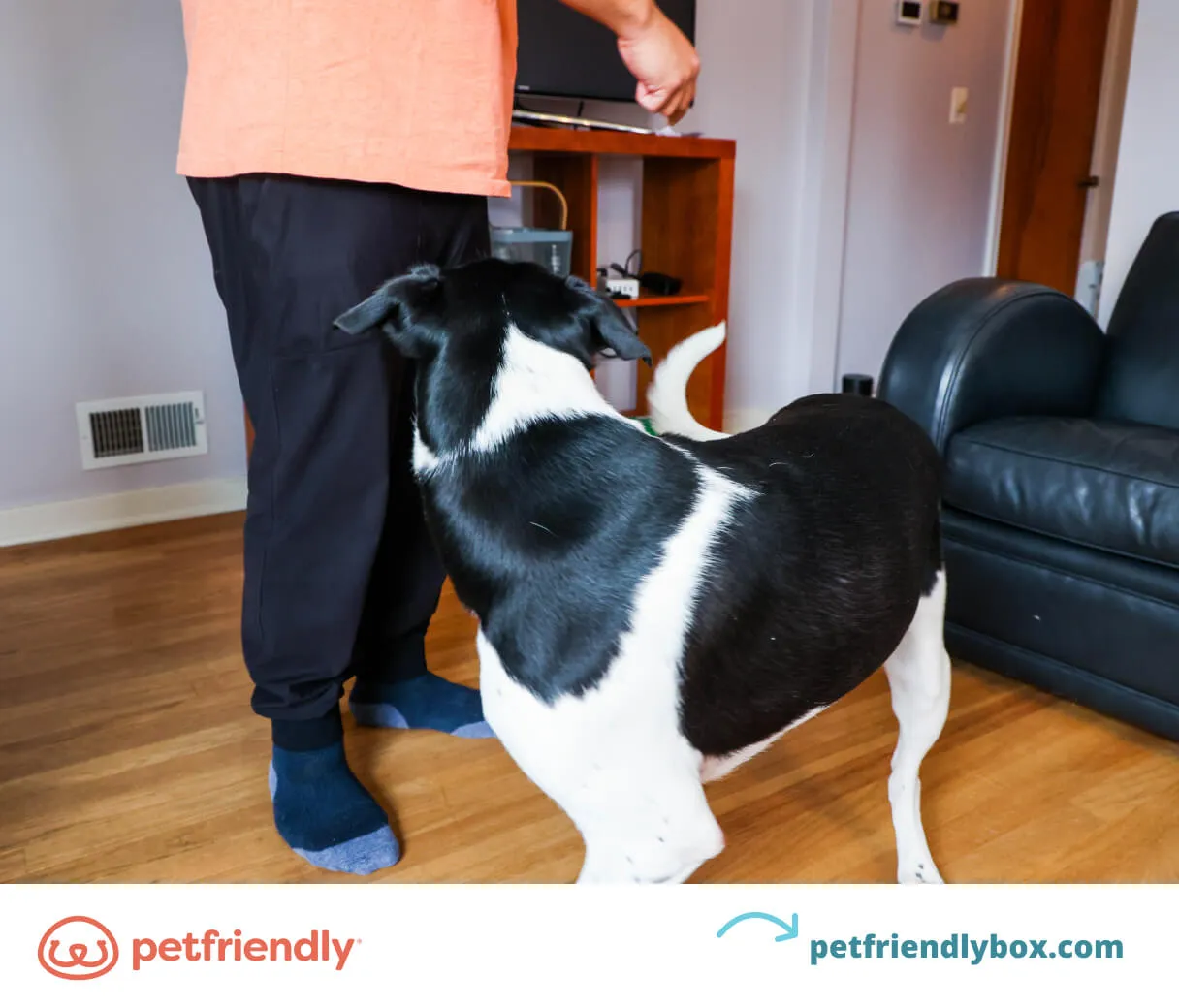Teaching your dog new tricks isn’t just about showing off; it’s a crucial part of responsible pet ownership. These tricks enhance your dog’s mental and physical stimulation, building a stronger bond between you and your furry friend. Dog training, in general, helps your canine companion develop essential skills, improve behavior, and boost their overall knowledge. A well-trained dog is a happier, more confident dog, and behaves better around other animals and people. Let’s explore some Essential Tricks To Teach Your Dog for better behavior.
1. Sit
 Dog Trick: Sit
Dog Trick: Sit
“Sit” is often the first command taught and is a foundational skill for many other tricks. Mastering “sit” helps your dog learn self-control and focus.
How to teach your dog to sit
Lure with a treat. Hold a high-value treat close to your dog’s nose. Slowly move the treat up and back, over their head. This encourages your dog to naturally lower into a sitting position.
Add the command. As your dog’s rear touches the ground, say “Sit!” immediately reward them with the treat and enthusiastic praise. Repeat this process, and soon your dog will associate the word “sit” with the action.
2. Stay
 Dog Tricks: Stay
Dog Tricks: Stay
The “stay” command is an important one for safety and impulse control. It teaches your dog to remain in place until released. Teaching this command can be easier if you’ve already completed some basic dog obedience training near me.
How to teach your dog to stay
Start with “sit.” Begin by having your dog sit. Once they are sitting calmly, say “Stay” in a firm but gentle voice.
Add the command. Initially, hold your hand up in a “stop” gesture. Wait a few seconds. If your dog remains seated, praise them calmly and give a small treat.
Increase the duration. Gradually increase the amount of time you expect your dog to stay. As they improve, you can also gradually increase the distance between you and your dog.
Release and repeat. Use a clear release word like “Okay” or “Free” to signal that your dog is released from the “stay.” Repeat this process regularly, and your dog will soon understand that “stay” means remaining in position until you give the release command.
Release words
A release word is essential for clarifying to your dog when the command is over. Common release words include:
- O.K.
- Release
- Go
- Break
- Free
Choose a word and use it consistently. Consistency is key for effective training your dog basic commands.
3. Come
 Dog Tricks: Come
Dog Tricks: Come
“Come” or “Here” is a vital command that can be life-saving in certain situations. It ensures that your dog returns to you when called, regardless of distractions.
How to teach your dog to come when called
Give them some space. Start in a safe, enclosed area with minimal distractions. Have your dog on a leash.
Add the command. Say your dog’s name enthusiastically, followed by the command “Come!” Gently tug on the leash to encourage them to move toward you. As they approach, shower them with praise.
Reward, reset, repeat. When your dog reaches you, give them a high-value treat and plenty of affection. Gradually increase the distance between you and your dog as they improve.
4. Leave it
 Dog Tricks: Leave It
Dog Tricks: Leave It
“Leave it” is an incredibly useful command for preventing your dog from picking up potentially dangerous objects or food items. It teaches them to ignore something you don’t want them to have.
How to teach your dog to leave it
Lure with a low-value treat. Place a treat in your closed hand. Show the closed fist to your dog and give the command “Leave it”.
Reward good behavior. Your dog will likely sniff, paw, and try to get to the treat. Ignore these attempts. When your dog stops trying to get the treat, even for a second, praise them and give them a treat from your other hand.
Make it challenging. Gradually increase the difficulty by placing the treat on the floor but covering it with your hand. Eventually, you can progress to leaving the treat uncovered on the floor. If your dog attempts to take the treat, cover it again and repeat the process. With patience and consistency, your dog will learn to “leave it” when instructed.
5. Down
 Dog Tricks: Down
Dog Tricks: Down
“Down” is a useful command for calming your dog in various situations, such as during vet visits or when guests arrive. It teaches them to lie down on command.
How to teach your dog down
Start with “sit.” Begin with your dog in a sitting position. Hold a treat in your hand and lower it towards the floor.
Lure with a high-value treat. As you lower the treat, move it slightly forward, encouraging your dog to follow the treat with their nose. This should cause them to lie down.
Add the command. As your dog lies down, say “Down!” and give them the treat. Repeat this process, and your dog will begin to associate the word “down” with the action of lying down. Basic obedience dog training near me courses often cover this command.
6. Place
 Dog Tricks: Place
Dog Tricks: Place
“Place” teaches your dog to go to a specific location, such as a bed or mat, and stay there until released. This is helpful for managing their behavior in various situations.
How to teach your dog place
Teach the basics. Before teaching “place,” ensure your dog knows “sit,” “down,” and “stay.”
Introduce your dog’s place. Choose a specific location, such as a dog bed or mat. Lure your dog toward the location with a treat.
Add the command. When your dog is on the “place,” say “Place!” and give them the treat. Gradually increase the amount of time they need to stay in the “place” before receiving the reward.
Increase the duration. You can also add distractions, such as walking away or making noise, to test their ability to stay in the “place.”
Add a challenge. Remember to use a release word when you want your dog to leave the “place.”
7. Back up
 Dog Tricks: Back Up
Dog Tricks: Back Up
“Back up” can be useful in tight spaces. It helps your dog become more aware of their body and movement.
How to teach your dog to back up
Start with an open space. Stand facing your dog. Hold a treat in your hand.
Step, step, reward. Gently move toward your dog, using your body language to encourage them to take a step back. As they step back, say “Back up!” and give them the treat.
Add the command. Repeat this process, gradually increasing the number of steps they take backward. With practice, your dog will learn to back up on command.
8. Shake paws
 Paw Shake Hands Dog Trick
Paw Shake Hands Dog Trick
“Shake” is a charming trick that is easy to teach and impresses friends and family.
How to teach your dog to shake hands (paws)
Start with “sit.” Have your dog sit. Hold a treat in your hand.
Add the command. Gently tap your dog’s leg. Most dogs will naturally lift their paw. As they lift their paw, say “Shake!” and take their paw in your hand.
Catch and repeat. Give them the treat. Repeat this process, and your dog will learn to associate the word “shake” with the action of lifting their paw.
9. Play dead (or rollover)
 Dog Trick: Play Dead
Dog Trick: Play Dead
“Play dead” or “rollover” is a fun trick that adds a bit of flair to your dog’s repertoire.
How to teach your dog to play dead
Start with your dog in a lying position. Have your dog lie down.
Lure with a high-value treat. Hold a treat near their nose and slowly move it to the side, encouraging them to roll onto their side. As they roll, say “Play dead!”
Reward. Once they are lying on their side, give them the treat. With repetition, your dog will learn to associate the command with the action.
Add the command. For “rollover,” continue luring them with the treat to roll onto their back and then onto their other side.
Bonus! Incorporate a hand signal. Remember to reward them each time they complete the action.
10. Speak
 Dog Trick: Speak
Dog Trick: Speak
“Speak” teaches your dog to bark on command. This can be helpful for managing excessive barking by teaching them when it’s appropriate to bark.
How to teach your dog to speak
Lure with an enticing reward. Hold a toy or treat that your dog loves.
Wait for a response. Excite your dog by waving the toy or treat around. Your dog may bark out of excitement or frustration.
Mark the bark. As soon as they bark, say “Speak!” and give them the toy or treat. Repeat this process, and your dog will learn to bark on command.
11. Take a bow
 Take a Bow Dog Trick
Take a Bow Dog Trick
“Take a bow” is a charming trick that showcases your dog’s flexibility.
How to teach your dog to take a bow
Lure with a high-value treat. Hold a treat near your dog’s nose.
Add the command. Slowly lower the treat towards the floor, encouraging your dog to stretch their front legs forward while keeping their rear in the air. As they bow, say “Bow!”
Add the command. Reward. Once they are in the bowing position, give them the treat.
12. Spin
 Dog Trick: Spin
Dog Trick: Spin
“Spin” is a fun and energetic trick that adds a touch of excitement to your dog’s repertoire.
How to teach your dog to spin
Lure with a high-value treat. Hold a treat near your dog’s nose.
Add the command. Slowly move the treat in a circle, encouraging your dog to follow the treat with their nose and turn their body in a circle. As they spin, say “Spin!”
Reward and repeat. Once they have completed a full circle, give them the treat. With practice, your dog will learn to spin on command. If you need help with the order of commands to teach puppy, consult with a professional trainer.
 Final Tips to Learn Tricks
Final Tips to Learn Tricks
Final tips for teaching your dog tricks
Here are some key things to keep in mind as you begin teaching:
- Keep training sessions short and fun.
- Use positive reinforcement techniques.
- Be patient and consistent.
- End each session on a positive note.
- Practice in various locations to generalize the behavior.
- Be aware of the commands to teach your puppy in order for optimal learning.
By incorporating these essential tricks into your dog’s training, you’ll not only improve their behavior but also strengthen your bond and enhance their overall well-being. Remember to always be patient, positive, and make training a fun and rewarding experience for both you and your furry companion.
